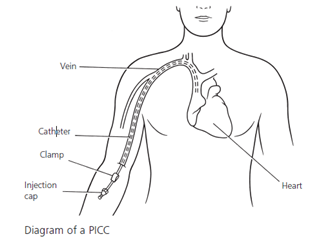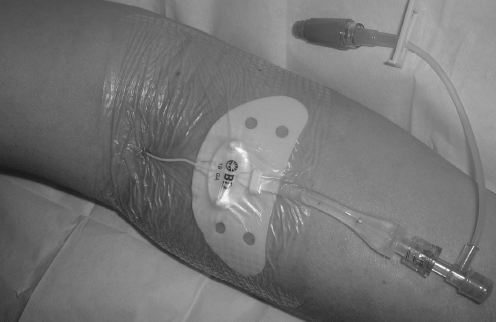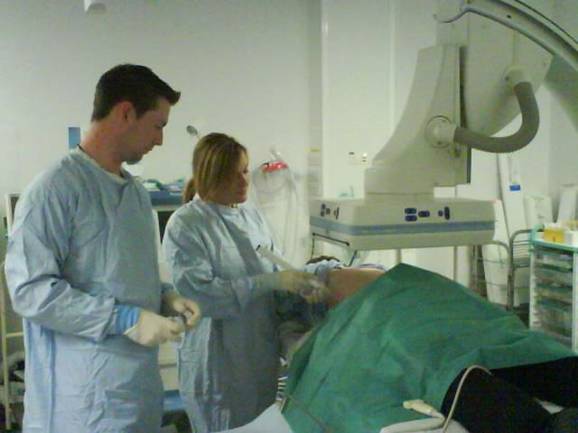Patients
-
- Angiography
- Angioplasty and Stenting
- Aortic Aneurysms
- Biliary Drainage and Stenting
- Carotid Artery Stenting
- Central Venous Access
- Colonic Stenting
- Fibroids
- Gastrointestinal Haemorrhage
- Gastrostomy
- Hepatic Malignancies
- Kidney Tumour Ablation
- Minimally Invasive Treatments for Vascular Disease
- Nephrostomy
- Oesophageal Stents
- Pelvic Venous Congestion Syndrome
- Percutaneous Nephrolithotomy
- Prostate Artery Embolisation PAE
- Pulmonary Arteriovenous Malformations
- PAE Patient Information Leaflet
- Ureteric Stenting
- Varicoceles
- Varicose Veins
- Vascular Malformations
- Vertebral Compression Fractures
- Vertebroplasty and Kyphoplasty
Central Venous Access
Why do I need venous access?
“Intravenous” medicines are given through a vein. If the intravenous (IV) medicine is needed short-term whilst you are in hospital then a standard IV drip into a small vein in the arm will be adequate.
However, some IV medications are required over a longer period of time. While standard IV drips work well for short-term treatment, they cannot be used for more than a few days.
One way of delivering long term IV medication is by Central Venous Access.
What is Central Venous Access?
Central venous access is when a long thin and hollow plastic tube called a ‘catheter’ or ‘line’ is placed in a vein and this provides a way of giving you regular IV medication. This has the advantage of not needing further IV access sites or repeated injections.
The long catheter is placed into a vein in the arm, neck or front of the chest. The catheter extends from its entry point into a ‘central vein’ next to the heart. The larger central vein can tolerate the catheter line much better than a small vein. The catheter can stay there safely for weeks or months, sometimes year more than a year.
What medications are given this way?
There are lots of types of IV medications which may need to be given repeatedly over a long period of time:
- Intravenous Antibiotic treatment
- Chemotherapy or anti-cancer drugs
- Haemodialysis - a treatment for patients whose kidneys are not working properly
In what other ways is Central Venous Access useful?
Drawing repeated blood samples.
Measuring blood pressure in a central vein. This can help manage how much fluid a patient needs.
In delivering large volumes of fluid or blood to patients quickly.
Treating patients in whom it may be technically difficult to use simple IV drips.
Central lines are much more stable and less likely to come out of the vein. This allows patients to be more active and receive IV medications at home.
Giving nutrition through the vein when food or supplements cannot be taken through the mouth, stomach or intestine.
Blood transfusions.
What happens during the central venous line insertion?
A medicine called ‘local anaesthetic’ is used to temporarily numb the area of skin where the catheter enters the body. The area of entry depends on the type of catheter used and may be a vein in the arm, groin, neck or front of the chest.
The line is then advanced into the central vein next to the heart using a combination of ultrasound and x-rays.
The “outside” part of the line is then secured to the skin with a temporary suture (a stitch) and a dressing.
Are there different types of catheters?
Yes. But only a few!


1. Peripherally-inserted central catheter - a PICC Line This is a line which enters one of the veins in the arm and travels to a central vein near the heart. Only a small length of the line is visible at the arm…..

2. Tunnelled catheter - This is a catheter which is placed in a large vein in the neck. Instead of the catheter coming out of the skin at the neck, it is “tunnelled” under the skin on the chest so that it exits the skin some distance away from where it enters the vein. This means that there is less chance of infection. Examples include the Hickmann® and Groshong® lines.
Once the skin is numb the catheter is placed into the vein in the arm or neck and then passed along into the central vein whilst using X-ray and Ultrasound images to guide the way.
The line is secured to the skin with either a special dressing or a suture.
Will I be awake during the procedure?
Yes. But we may give you some sedation which makes you a little sleepy depending on the type of catheter being placed.
Who performs the procedure and where?
 A Radiologist – this is a doctor who is specially trained in using the X-ray equipment and ultrasound scanner to guide him or her during procedures such as this. Alternatively, a specially trained nurse or a surgeon may carry out the procedure.
A Radiologist – this is a doctor who is specially trained in using the X-ray equipment and ultrasound scanner to guide him or her during procedures such as this. Alternatively, a specially trained nurse or a surgeon may carry out the procedure.
The procedure is carried out in a specially designed room which has X-ray and Ultrasound scanning facilities as well as patient monitoring equipment.
